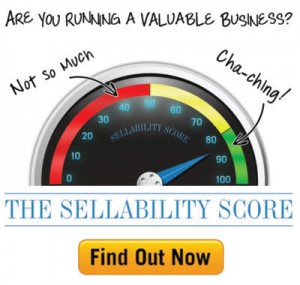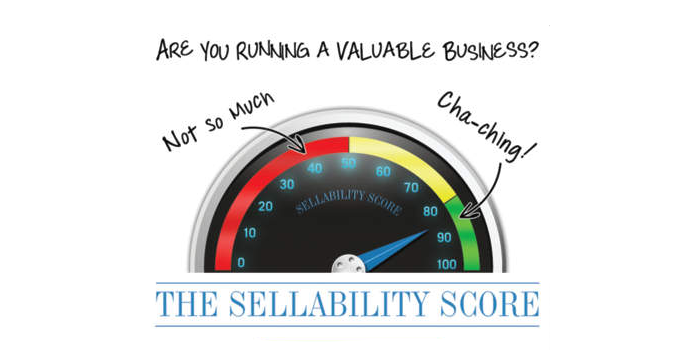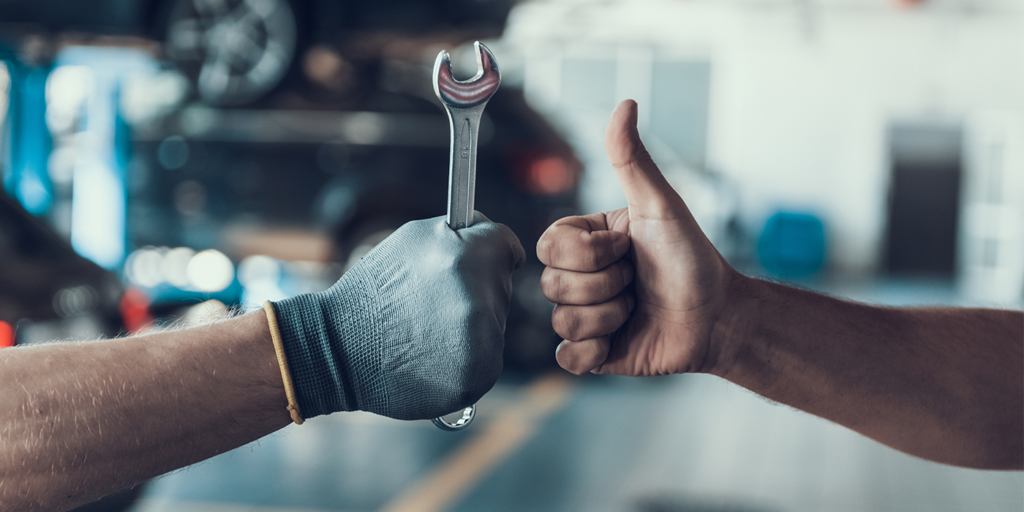Most of us know the FICO score is a critical element lenders use to determine such things as our personal creditworthiness and corresponding maximum available loans and interest rates. Of course, a number of other factors such as debt-to-income ratio, employment history, general credit history and other specific underwriting policies may also be used by lenders to decide the amount and terms of credit being extended.
We also know that we may be able to increase our FICO scores over time by practicing responsible personal financial management.
But there is an even more significant score for shop owners contemplating a sale of their business called the “Sellability Score.”
Just as the FICO score has evolved in its significance as a factor in the credit process, the Sellability Score is being utilized by a growing number of prospective business buyers to determine whether or not an asking price is justified.
Sellability Score Are You Running A Valuable Business?
It’s fun to imagine how much your business is worth. It’s not as much fun when you find out that for all the energy you poured into it, a business broker or potential buyer can’t see the value you can, or thinks your number is unrealistic.
“Sellability” is a powerful indicator — regardless of whether or not you have any intention or interest in selling your business today — because it points directly to the underlying issues in your business that may undermine your value. Those same issues are probably causing mounting frustration for you — the feelings of being overwhelmed, working too many hours, dealing with inconsistent customer experiences and the difficulties of managing cash flow.
Whatever your personal and financial goals are for your business, as a responsible business owner, you simply have to be able to answer these questions:
- If you wanted to, could you sell your business today for a number that you’d be happy with?
- Is there anything that you could be doing each day to make your business more valuable?
- What steps can you take to reduce the number of hours that you work, while simultaneously boosting the profits and the sellability of your business?
The “Sellability Score” can assist you in answering these questions.
Whether you want to sell next year or a decade from now, or pass the business to a family member, you strive to build a branded asset that someone would value monetarily — otherwise, you just have a job, not a business.
The Sellability Score is an interactive tool offering a comprehensive assessment of the “sellability” of your business. In just 26 minutes, this absolutely free and confidential self-assessment tool will score your business in a number of key areas and tell you just how sellable your business is. Thousands of business owners worldwide have benefited by participating in this free questionnaire.
To make the Sellability Score even more pertinent to the automotive aftermarket, I have supplemented the standardized online questionnaire with an additional set of questions designed specifically to examine the key factors used by buyers to determine which auto service business to buy and how much to offer. Each questionnaire takes about 13 minutes to complete.
How Does It Work?
All you need to do is visit my website www.art-blumenthal.com and click on the button for the Sellability Score. You will see links for both the standardized and the aftermarket specific questionnaires.
When you complete the two parts of the Sellability questionnaires, you’ll receive:
- A standardized Sellability Score that ranks your business among all other businesses, and
- An aftermarket Sellability Score that evaluates the sellability of your business compared to other automotive service businesses.
The standardized Sellability Score, a scale of zero to 100, is based upon key drivers of sellability, which are statistically proven to increase the value of your company. The developers of the tool studied 6,955 businesses and correlated the positive and negative attributes of each business with their ultimate selling price compared to similar businesses.
The aftermarket Sellability Score drills down deeper into the details of your business and pinpoints key elements that are most attractive to aftermarket buyers. Your responses, as well as other publicly available data about your area and location will be analyzed to provide an assessment of how your business compares to other automotive businesses in terms of sellability. The aftermarket sellability key factor analysis is based on my 37 years in the automotive aftermarket and successfully selling dozens of automotive businesses.
Last year, I represented a seller whose business was so sellable it was under contract with a buyer in two days, with a 10% premium over what the seller thought it was worth. Other less sellable businesses took two years to find a qualified buyer. The higher your Sellability Score, the less time it will likely take to sell your business and the more money you will get for it.
The Science Behind The Score
The Sellability Score algorithm was developed using a quantitative survey of business owners and is continually refined, based on the thousands of business owners who get their score each quarter.
Is your business your largest asset? Achieve a Sellability Score of 80+ out of a possible 100 and, based on research from thousands of test cases, your shop may be worth 71% more than the average business.
Your overall Sellability Score is derived from your performance, based upon your answers to 32 questions, on the following eight attributes that drive the value of your company:
- Financial Performance: Your history of producing revenue and profit combined with the professionalism of your record keeping. A buyer sees buying a business as paying today for a stream of profits in the future, which is why companies are generally bought and sold using a multiple of cash flow. Buyers look at your historical financials, but they are really buying what they think the cash flow will be in future years. If there is a growth trend in your sales and profits, your business will score better. If there are opportunities for profit growth that you have not capitalized on, then convincing a buyer that they are realistic will increase the value of your business. If the buyer perceives that your automotive business will not grow in profits, or that there is significant risk of a decline in profits, then you are likely to get a lower offer for your business.
- Growth Potential: Your likelihood to grow your business in the future and at what rate. Buyers typically pay the most for businesses with the potential to grow. Your score on the Growth Potential attribute reflects the extent to which you think your business can grow in the future by expanding your automotive services to your existing customers or by acquiring new customers, such as increasing your fleet business or doing target marketing to an expanded geographic area.
- The “Switzerland Structure”: How dependent your business is on any one employee, customer or supplier. The sellability of a business requires that the business not be overly reliant on any one customer, employee or supplier. The name “The Switzerland Structure” was inspired by Switzerland’s focus on neutrality and not being dependent upon other countries.
Buyers will perceive risk in your business if you have multiple family members or key employees who may not continue with a new owner. Also, if you have a few key customers or fleet accounts which contribute a sizable percentage of your revenue, then this dependency may negatively impact your Sellability Score. - The “Valuation Teeter-Totter”: Whether your business is a cash drain or a cash spigot. The Valuation Teeter-Totter reflects the impact your cash flow, gross margin and profitability have on the value of your company. Imagine a playground teeter-totter that can move in only two directions: when one end goes down, the other must go up. The same is true of the value of your company as it relates to your cash flow: the more cash a buyer must inject into your company when taking it over, the less that buyer will pay for it. The inverse is also true: the less cash your buyer must deposit into your business, the higher the price he or she will pay.
If your building and equipment is up to date and well maintained, then a buyer will not feel that they have to make a huge capital investment if they purchase your business. If the buyer believes that the cash flow will be positive as soon as they take over, then you will get a higher price for your business. - The Hierarchy of Recurring Revenue: The proportion and quality of automatic, annuity-based revenue you collect each month. Businesses with a sizable percentage of monthly recurring revenue, such as software companies your shop may have contracts with, would achieve a high score under this particular driver of sellability. It would be nice if you could charge your customer’s credit card $150 each month for a service contract to do their oil changes and routine maintenance, but I have not heard of a repair shop that was successful at implementing such a program.
However, to the extent that you have marketing programs that encourage regular visits for routine maintenance services and safety inspections, you are more likely to benefit from consistent revenue from a customer base that makes multiple purchases over the course of a year. - The Monopoly Control: How differentiated is your business from competitors in your industry? Billionaire Warren Buffett is famous for investing in companies with a protective “moat” around them. The deeper and wider the moat, the harder it is for competitors to compete. In addition, an enduring competitive advantage also gives an owner more control over pricing, which increases both profitability and cash flow.
Unique and meaningful business differentiation means thinking less about how to compete on price and more about what differentiates your business from its competitors. If you’re not sure what your point of differentiation could be, focus on finding something that is both unique and meaningful to customers, and stake a claim to it.
Questions you might consider to develop differentiation of your business include:- Is there a layer of service you could add to differentiate your offering, such as loaner cars or a shuttle service?
- How can you better brand your products and services, such as an improved warranty?
- What is the one thing that auto service customers care most about?
- Customer Satisfaction: The likelihood that your customers will re-purchase and also refer you. Most business owners know intuitively how satisfied their customers are, but as their companies grow, some owners lose touch with their customers. Do you have an objective way of regularly measuring the satisfaction of your customers?
Many shops do internal customer surveys to measure customer satisfaction. A potential buyer of your business is most likely going to check out your consumer reviews on Yelp, Yahoo, Angie’s List and Google. Having good online reviews gives a buyer comfort that your existing customers will return again and you will attract new Internet savvy consumers who make their initial buying decision based upon the experiences of others. - Hub & Spoke: How your business would perform if you were unexpectedly unable to work for a period of three months. This factor measures the extent to which your business can thrive without you. Few sellers of an automotive aftermarket business stay on after a sale to work for the buyer. One of the key drivers of sellability is having a solid team of well trained employees who know how to do their jobs independent of your constant direction. You may have created a highly profitable business, but if your key employees are not capable of running it without you, or if your customer base will bring their vehicles elsewhere if you are no longer there, then a buyer will factor in the risk of a post-closing sales decline when they formulate their offer price.
To be valuable to a buyer, your business must be able to succeed and grow without you at the hub of all activities, and your employees must be more than mere spokes that cannot operate independently of you. And the more your customers need you and ask for you personally, the harder it is for you to scale back your hours, take a vacation or eventually sell your business.
Your business is significantly more valuable if you are successful at building a “brand,” not simply a place where your own reputation and your personal handling of customers is what brings them back. It’s the difference between thinking of yourself as having a “job” that requires you to show up at work to make money, versus creating a “business” where the brand is more important than the personality of the founder.
The majority of buyers who contact me don’t want to be a slave to the business and work every hour that the business is open. In fact, many buyers already own a business and are looking to supplement their income by purchasing an additional business where they will provide part-time supervision and marketing and business acumen. These buyers will pay a premium for a business that can clearly demonstrate its ability to run profitably without the seller as the critical hub.
Building An Exit Plan Using the Sellability Score
When you spend a lifetime trying to build a successful business, it leaves little time for much else, including thinking about an exit plan; but even if you are planning to pass the business on to family, you want to ensure you are offering them a valuable business. Whether you are creating an exit plan for the short term or years into the future, it’s never too late or too soon to start understanding — and increasing — the value of your business.
Seventy percent of all business owners in today’s market plan to sell or pass their business on within 10 years. But 76% don’t have an exit plan, and many do not know the value of their business.
A well thought out exit plan can:
- Protect the legacy of your business;
- Build value for your business;
- Provide financial security for your family and your stakeholders;
- Make it easier to deal with any unexpected events (illness, accident or death); and
- Help to prepare you and your business for the future.
Both the standardized Sellability Score questionnaire and the customized, aftermarket-specific questionnaire are available for free at a link on my website www.art-blumenthal.com. Each is easy to use and takes about 13 minutes to complete.
After completing the questionnaires online, you will immediately be provided with a raw score for your business and a summary of what the score means. Meanwhile, based upon your questionnaire answers, I will develop and provide a comprehensive report for your business which we can later review together.
Look for Part 2 of “Do You Know Your Shop’s Sellability Score?” in the November/December 2014 issue of Shop Owner, where we will delve deeper into aftermarket-specific key factors of your “Sellability Score” and how buyers use them to determine whether or not to offer a premium price for an automotive service business.
—–
Art Blumenthal














